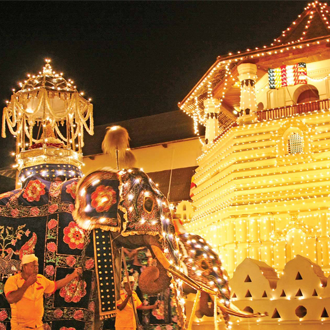Kany - Esala Pereahera
Kandy Esala Perahera is an annual Buddhist festival in Sri Lanka held in July or August. The festival features a grand procession with traditional dancers, drummers, and lavishly decorated elephants. Devotees and tourists gather to witness the sacred tooth relic of Buddha paraded through the streets. The event is a significant cultural and religious celebration. Read more...
Kandy Esala Perahera, one of Sri Lanka's most significant and grandest festivals, is celebrated with immense fervor in the city of Kandy. This annual event, typically held in July or August, lasts for ten days and is a vibrant display of Sri Lankan culture and Buddhist traditions. The festival is dedicated to the sacred tooth relic of Lord Buddha, housed in the Temple of the Tooth, also known as Sri Dalada Maligawa. This relic is deeply revered, and the Perahera is held to honor and seek blessings from it.
The origins of Esala Perahera date back to ancient times, with its roots in both Hindu and Buddhist rituals. The festival as it is known today began in the 18th century when the sacred tooth relic was brought to Kandy. Over the years, it has evolved into a spectacular procession, blending various elements of Sri Lankan cultural heritage.
The Perahera consists of five separate processions, each representing a different deity: the Temple of the Tooth, Natha, Vishnu, Kataragama, and Pattini. Each procession is an elaborate affair, featuring a plethora of traditional performers, including drummers, dancers, musicians, and torchbearers. The most striking participants are the elephants, adorned with intricate and colorful costumes, with the main elephant, or the Maligawa Tusker, carrying the golden casket containing the sacred tooth relic.
The festival begins with the Kap Situveema, a ritual where a sanctified young jackfruit tree is planted in each of the four devales (temples) dedicated to the guardian gods. This is followed by the Kumbal Perahera, the initial processions held for five days, gradually increasing in grandeur and attendance. The final five nights are marked by the Randoli Perahera, which is even more lavish and spectacular, culminating in the Maha Randoli Perahera on the final night, which is the most magnificent of all.
On the day following the final Randoli Perahera, the Diya Kepeema ritual is performed at the Mahaweli River, symbolizing purification. This is followed by the Day Perahera, a daytime procession marking the conclusion of the festival.
Kandy Esala Perahera attracts thousands of devotees and tourists from around the world, eager to witness this unique blend of spirituality and cultural pageantry. The festival not only serves as a religious observance but also as a celebration of Sri Lankan heritage, showcasing traditional music, dance, and art forms. It is a testament to the island's rich history and the enduring significance of the sacred tooth relic in the spiritual life of the Sri Lankan people.
This year's Perahera has been particularly noteworthy, drawing record crowds and featuring a special emphasis on eco-friendly practices. Organizers have made efforts to reduce the environmental impact of the event, including the use of reusable materials and minimizing waste. Additionally, the event has seen increased international media coverage, highlighting its cultural importance and the stunning visual spectacle it offers. The festival remains a powerful symbol of unity, faith, and tradition, continuing to captivate and inspire those who experience it.




